A Holistic Modelling Approach for the Estimation of Return Levels of Peak Flows in Bavaria
Abstract
1. Introduction
2. Study Area, Data, and Methods
2.1. Study Area
2.2. Data
2.2.1. Spatial Model Inputs and Discharge Data
2.2.2. Meteorological Data
2.3. Methods
2.3.1. The Holistic Modelling Approach
2.3.2. The Hydrological Model and Parameterization Approach
2.3.3. Evaluation of Simulated Return Levels
3. Results
3.1. Results from the Holistic Modelling
3.2. Qualitiy Assessment of the Representation of Return Levels
4. Discussion
4.1. On the Holistic Model Approach
4.2. On the LOT
5. Conclusions
Supplementary Materials
Author Contributions
Funding
Acknowledgments
Conflicts of Interest
References
- Collins, M.; Knutti, R.; Arblaster, J.; Dufresne, J.-L.; Fichefet, T.; Friedlingstein, P.; Gao, X.; Gutowski, W.J.; Johns, T.; Krinner, G.; et al. Long-term climate change: Projections, commitments and irreversibility. In Climate Change 2013-The Physical Science Basis: Contribution of Working Group I to the Fifth Assessment Report of the Intergovernmental Panel on Climate Change; Stocker, T.F., Qin, D., Plattner, G.-K., Tignor, M., Allen, S.K., Boschung, J., Nauels, A., Xia, Y., Bex, V., Midgley, P.M., Eds.; Cambridge University Press: Cambridge, UK, 2013; pp. 1029–1136. ISBN 9781107057991. [Google Scholar]
- IPCC. Climate Change 2014: Synthesis Report. Contribution of Working Groups I, II and III to the Fifth Assessment Report of the Intergovernmental Panel on Climate Change; Pachauri, R., Meyer, L., Eds.; IPCC: Geneva, Switzerland, 2014; p. 151. [Google Scholar]
- Dooge, J.C.I. Looking for hydrologic laws. Water Resour. Res. 1986, 22, 46–58. [Google Scholar] [CrossRef]
- Leduc, M.; Mailhot, A.; Frigon, A.; Martel, J.-L.; Ludwig, R.; Brietzke, G.B.; Giguère, M.; Brissette, F.; Turcotte, R.; Braun, M. The ClimEx Project: A 50-member ensemble of climate change projections at 12-km resolution over Europe and Northeastern North America with the Canadian regional climate model (CRCM5). J. Appl. Meteorol. Climatol. 2019, 58, 663–693. [Google Scholar] [CrossRef]
- Van Vuuren, D.P.; Edmonds, J.; Kainuma, M.; Riahi, K.; Thomson, A.; Hibbard, K.; Hurtt, G.C.; Kram, T.; Krey, V.; Lamarque, J.-F.; et al. The representative concentration pathways: An overview. Clim. Chang. 2011, 109, 5. [Google Scholar] [CrossRef]
- Mauser, W.; Prasch, M. (Eds.) Regional Assessment of Global Change Impacts: The Project GLOWA-Danube; Springer: Berlin/Heidelberg, Germany, 2015. [Google Scholar] [CrossRef]
- Muerth, M.; Gauvin St-Denis, B.; Ricard, S.; Velázquez, J.A.; Schmid, J.; Minville, M.; Caya, D.; Chaumont, D.; Ludwig, R.; Turcotte, R. On the need for bias correction in regional climate scenarios to assess climate change impacts on river runoff. Hydrol. Earth Syst. Sci. 2013, 17, 1189–1204. [Google Scholar] [CrossRef]
- Velázquez, J.A.; Schmid, J.; Ricard, S.; Muerth, M.J.; St-Denis, B.G.; Minville, M.; Chaumont, D.; Caya, D.; Ludwig, R.; Turcotte, R. An ensemble approach to assess hydrological models’ contribution to uncertainties in the analysis of climate change impact on water resources. Hydrol. Earth Syst. Sci. 2013, 17, 565–578. [Google Scholar] [CrossRef]
- Mauser, W.; Bach, H. PROMET–Large scale distributed hydrological modelling to study the impact of climate change on the water flows of mountain watersheds. J. Hydrol. 2009, 376, 362–377. [Google Scholar] [CrossRef]
- Schulla, J. Model Description WaSiM: (Water Balance Simulation Model). Available online: www.wasim.ch (accessed on 9 June 2020).
- Hattermann, F.F.; Wortmann, M.; Liersch, S.; Toumi, R.; Sparks, N.; Genillard, C.; Schröter, K.; Steinhausen, M.; Gyalai-Korpos, M.; Máté, K.; et al. Simulation of flood hazard and risk in the Danube basin with the Future Danube Model. Clim. Serv. 2018, 12, 14–26. [Google Scholar] [CrossRef]
- Krysanova, V.; Hattermann, F.; Wechsung, F. Development of the ecohydrological model SWIM for regional impact studies and vulnerability assessment. Hydrol. Process. 2005, 19, 763–783. [Google Scholar] [CrossRef]
- Beven, K.; Freer, J. Equifinality, data assimilation, and uncertainty estimation in mechanistic modelling of complex environmental systems using the GLUE methodology. J. Hydrol. 2001, 249, 11–29. [Google Scholar] [CrossRef]
- Ricard, S.; Bourdillon, R.; Rousse, L.D.; Turcotte, R. Global Calibration of Distributed Hydrological Models for Large-Scale Applications. J. Hydrol. Eng. 2013, 18, 719–721. [Google Scholar] [CrossRef]
- Bárdossy, A. Calibration of hydrological model parameters for ungauged catchments. Hydrol. Earth Syst. Sci. 2007, 11, 703–710. [Google Scholar] [CrossRef]
- Samaniego, L.; Kumar, R.; Attinger, S. Multiscale parameter regionalization of a grid-based hydrologic model at the mesoscale. Water Resour. Res. 2010, 46. [Google Scholar] [CrossRef]
- Kouchi, D.H.; Esmaili, K.; Faridhosseini, A.; Sanaeinejad, S.H.; Khalili, D.; Abbaspour, K.C. Sensitivity of Calibrated Parameters and Water Resource Estimates on Different Objective Functions and Optimization Algorithms. Water 2017, 9, 384. [Google Scholar] [CrossRef]
- Gaborit, É.; Ricard, S.; Lachance-Cloutier, S.; Anctil, F.; Turcotte, R. Comparing global and local calibration schemes from a differential split-sample test perspective. Can. J. Earth Sci. 2015, 52, 990–999. [Google Scholar] [CrossRef]
- Merz, R.; Blöschl, G. Regionalisation of catchment model parameters. J. Hydrol. 2004, 287, 95–123. [Google Scholar] [CrossRef]
- Xu, C.-Y.; Widén, E.; Halldin, S. Modelling hydrological consequences of climate change—Progress and challenges. Adv. Atmos. Sci. 2005, 22, 789–797. [Google Scholar] [CrossRef]
- Blöschl, G.; Sivapalan, M. Scale issues in hydrological modelling: A review. Hydrol. Process. 1995, 9, 251–290. [Google Scholar] [CrossRef]
- Poschlod, B.; Willkofer, F.; Ludwig, R. Impact of Climate Change on the Hydrological Regimes in Bavaria. Water 2020, 12, 1599. [Google Scholar] [CrossRef]
- European Environment Agency. Digital Elevation Model over Europe (EU-DEM). 2013. Available online: https://www.eea.europa.eu/data-and-maps/data/eu-dem (accessed on 9 June 2020).
- European Environment Agency. Corine Land Cover 2006 v17. 2013. Available online: https://www.eea.europa.eu/data-and-maps/data/clc-2006-raster-3 (accessed on 9 June 2020).
- European Commission and the European Soil Bureau Network. The European Soil Database Distribution Version 2.0 EUR 19945 EN. 2004. Available online: https://esdac.jrc.ec.europa.eu/content/european-soil-database-v20-vector-and-attribute-data (accessed on 9 June 2020).
- Panagos, P. The European soil database. GEO Connex. 2006, 5, 32–33. [Google Scholar]
- Wösten, J.H.M.; Lilly, A.; Nemes, A.; Le Bas, C. Development and use of a database of hydraulic properties of European soils. Geoderma 1999, 90, 169–185. [Google Scholar] [CrossRef]
- Dörhöfer, G.; Hannappel, S.; Reutter, E.; Voigt, H.-J. Die Hydrogeologische Übersichtskarte von Deutschland HÜK200. Z. Für Angew. Geol. 2001, 47, 153–159. [Google Scholar]
- BGR; UNESCO (Eds.) International Hydrogeological Map of Europe 1:1,500,000 (IHME1500 v1.1); Bundesanstalt für Geowissenschaften und Rohstoffe (BGR): Hannover, Germany; Paris, France, 2014. [Google Scholar]
- Shamra, A.; Srikanthan, S. Continuous rainfall simulation: A nonparametric alternative. In Proceedings of the 30th Hydrology & Water Resources Symposium: Past, Present & Future, Launceston, Australia, 4–7 December 2006. [Google Scholar]
- Pui, A.; Sharma, A.; Mehrotra, R.; Sivakumar, B.; Jeremiah, E. A comparison of alternatives for daily to sub-daily rainfall disaggregation. J. Hydrol. 2012, 470, 138–157. [Google Scholar] [CrossRef]
- Westra, S.; Mehrotra, R.; Sharma, A.; Srikanthan, R. Continuous rainfall simulation: 1. A regionalized subdaily disaggregation approach. Water Resour. Res. 2012, 48. [Google Scholar] [CrossRef]
- Poschlod, B.; Hodnebrog, Ø.; Wood, R.R.; Alterskjær, K.; Ludwig, R.; Myhre, G.; Sillmann, J. Comparison and Evaluation of Statistical Rainfall Disaggregation and High-Resolution Dynamical Downscaling over Complex Terrain. J. Hydrometeorol. 2018, 19, 1973–1982. [Google Scholar] [CrossRef]
- Rauthe, M.; Steiner, H.; Riediger, U.; Mazurkiewicz, A.; Gratzki, A. A Central European precipitation climatology—Part I: Generation and validation of a high-resolution gridded daily data set (HYRAS). Meteorol. Z. 2013, 22, 235–256. [Google Scholar] [CrossRef]
- Monteith, J.L. Evaporation and environment. Symp. Soc. Exp. Biol. 1965, 19, 205–234. [Google Scholar]
- Warscher, M.; Strasser, U.; Kraller, G.; Marke, T.; Franz, H.; Kunstmann, H. Performance of complex snow cover descriptions in a distributed hydrological model system: A case study for the high Alpine terrain of the Berchtesgaden Alps. Water Resour. Res. 2013, 49, 2619–2637. [Google Scholar] [CrossRef]
- Richards, L.A. Capillary conduction of liquids through porous mediums. Physics 1931, 1, 318–333. [Google Scholar] [CrossRef]
- Liersch, S.; Drews, M.; Pilz, T.; Salack, S.; Sietz, D.; Aich, V.; Larsen, M.A.D.; Gädeke, A.; Halsnæs, K.; Thiery, W. One simulation, different conclusions—The baseline period makes the difference! Environ. Res. Lett. 2020. [Google Scholar] [CrossRef]
- Tolson, B.A.; Shoemaker, C.A. Dynamically dimensioned search algorithm for computationally efficient watershed model calibration. Water Resour. Res. 2007, 43. [Google Scholar] [CrossRef]
- Behrangi, A.; Khakbaz, B.; Vrugt, J.A.; Duan, Q.; Sorooshian, S. Comment on “Dynamically dimensioned search algorithm for computationally efficient watershed model calibration” by Bryan A. Tolson and Christine A. Shoemaker. Water Resour. Res. 2008, 44. [Google Scholar] [CrossRef]
- Huang, X.; Liao, W.; Lei, X.; Jia, Y.; Wang, Y.; Wang, X.; Jiang, Y.; Wang, H. Parameter optimization of distributed hydrological model with a modified dynamically dimensioned search algorithm. Environ. Model. Softw. 2014, 52, 98–110. [Google Scholar] [CrossRef]
- Arsenault, R.; Poulin, A.; Côté, P.; Brissette, F. Comparison of stochastic optimization algorithms in hydrological model calibration. J. Hydrol. Eng. 2014, 19, 1374–1384. [Google Scholar] [CrossRef]
- Nash, J.E.; Sutcliffe, J.V. River flow forecasting through conceptual models part I—A discussion of principles. J. Hydrol. 1970, 10, 282–290. [Google Scholar] [CrossRef]
- Gupta, H.V.; Kling, H.; Yilmaz, K.K.; Martinez, G.F. Decomposition of the mean squared error and NSE performance criteria: Implications for improving hydrological modelling. J. Hydrol. 2009, 377, 80–91. [Google Scholar] [CrossRef]
- Moriasi, D.N.; Arnold, J.G.; van Liew, M.W.; Bingner, R.L.; Harmel, R.D.; Veith, T.L. Model evaluation guidelines for systematic quantification of accuracy in watershed simulations. Trans. ASABE 2007, 50, 885–900. [Google Scholar] [CrossRef]
- Krause, P.; Boyle, D.P.; Bäse, F. Comparison of different efficiency criteria for hydrological model assessment. Adv. Geosci. 2005, 5, 89–97. [Google Scholar] [CrossRef]
- Bezak, N.; Brilly, M.; Šraj, M. Comparison between the peaks-over-threshold method and the annual maximum method for flood frequency analysis. Hydrol. Sci. J. 2014, 59, 959–977. [Google Scholar] [CrossRef]
- Curceac, S.; Atkinson, P.M.; Milne, A.; Wu, L.; Harris, P. An evaluation of automated GPD threshold selection methods for hydrological extremes across different scales. J. Hydrol. 2020, 585, 124845. [Google Scholar] [CrossRef]
- Lang, M.; Ouarda, T.B.M.J.; Bobée, B. Towards operational guidelines for over-threshold modeling. J. Hydrol. 1999, 225, 103–117. [Google Scholar] [CrossRef]
- Solari, S.; Losada, M.A. A unified statistical model for hydrological variables including the selection of threshold for the peak over threshold method. Water Resour. Res. 2012, 48. [Google Scholar] [CrossRef]
- Pickands, J. Statistical Inference Using Extreme Order Statistics. Ann. Stat. 1975, 3, 119–131. [Google Scholar] [CrossRef]
- Balkema, A.A.; de Haan, L. Residual Life Time at Great Age. Ann. Probab. 1974, 2, 792–804. [Google Scholar] [CrossRef]
- Scarrott, C.; MacDonald, A. A review of extreme value threshold estimation and uncertainty quantification. REVSTAT Stat. J. 2012, 10, 33–60. [Google Scholar]
- Bernardara, P.; Mazas, F.; Kergadallan, X.; Hamm, L. A two-step framework for over-threshold modelling of environmental extremes. Nat. Hazards Earth Syst. Sci. 2014, 14, 635. [Google Scholar] [CrossRef]
- Coles, S.; Bawa, J.; Trenner, L.; Dorazio, P. An Introduction to Statistical Modeling of Extreme Values; Springer: Berlin/Heidelberg, Germany, 2001. [Google Scholar] [CrossRef]
- Gharib, A.; Davies, E.; Goss, G.; Faramarzi, M. Assessment of the Combined Effects of Threshold Selection and Parameter Estimation of Generalized Pareto Distribution with Applications to Flood Frequency Analysis. Water 2017, 9, 692. [Google Scholar] [CrossRef]
- Cunnane, C. A note on the Poisson assumption in partial duration series models. Water Resour. Res. 1979, 15, 489–494. [Google Scholar] [CrossRef]
- Fischer, S.; Schumann, A. Robust flood statistics: Comparison of peak over threshold approaches based on monthly maxima and TL-moments. Hydrol. Sci. J. 2016, 61, 457–470. [Google Scholar] [CrossRef]
- Hosking, J.R.M. L-Moments: Analysis and Estimation of Distributions Using Linear Combinations of Order Statistics. J. R. Stat. Soc. Ser. B 1990, 52, 105–124. [Google Scholar] [CrossRef]
- Hosking, J.R.M.; Wallis, J.R. Regional Frequency Analysis. An Approach Based on L-Moments; Cambridge University Press: Cambridge, UK, 1997. [Google Scholar] [CrossRef]
- Reiss, R.-D.; Thomas, M. Statistical Analysis of Extreme Values. with Applications to Insurance, Finance, Hydrology and Other Fields, 3rd ed.; Birkhäuser Verlag AG: Basel, Switzerland, 2007. [Google Scholar] [CrossRef]
- Robson, A.; Reed, D. Flood Estimation Handbook Volume 3: Statistical Procedures for Flood Frequency Estimation; Centre for Ecology and Hydrology: Wallingford, UK, 1999; ISBN 0948540915. [Google Scholar]
- Bačová-Mitková, V.; Onderka, M. Analysis of extreme hydrological Events on the Danube using the Peak Over Threshold method. J. Hydrol. Hydromech. 2010, 58, 88–101. [Google Scholar] [CrossRef]
- Prein, A.F.; Gobiet, A. Impacts of uncertainties in European gridded precipitation observations on regional climate analysis. Int. J. Climatol. 2017, 37, 305–327. [Google Scholar] [CrossRef] [PubMed]
- Meyer, J.; Kohn, I.; Stahl, K.; Hakala, K.; Seibert, J.; Cannon, A.J. Effects of univariate and multivariate bias correction on hydrological impact projections in alpine catchments. Hydrol. Earth Syst. Sci. 2019, 1339–1354. [Google Scholar] [CrossRef]
- Bayerisches Landesamt für Umwelt. Allgemeine Daten zur Wasserwirtschaft. Available online: https://www.lfu.bayern.de/wasser/allgemeine_daten_wasserwirtschaft/index.htm (accessed on 2 July 2020).
- United States Department of Agricultire (USDA). Soil Survey Manual; Government Printing Office: Washington, DC, USA, 1951.
- Deutscher Verband für Wasserwirtschaft und Kulturbau Fachausschuss Verdunstung. Ermittlung der Verdunstung von Land- und Wasserflächen; Wirtschafts- und Verl.-Ges. Gas und Wasser: Bonn, Germany, 1996; Volume 238, pp. 1–135. ISBN 389554034X. [Google Scholar]
- Tolson, B.A.; Shoemaker, C.A. Efficient prediction uncertainty approximation in the calibration of environmental simulation models. Water Resour. Res. 2008, 44. [Google Scholar] [CrossRef]
- Gupta, H.V.; Sorooshian, S.; Yapo, P.O. Status of Automatic Calibration for Hydrologic Models: Comparison with Multilevel Expert Calibration. J. Hydrol. Eng. 1999, 4, 135–143. [Google Scholar] [CrossRef]
- Seong, C.; Her, Y.; Benham, B. Automatic Calibration Tool for Hydrologic Simulation Program-FORTRAN Using a Shuffled Complex Evolution Algorithm. Water 2015, 7, 503–527. [Google Scholar] [CrossRef]
- Mizukami, N.; Rakovec, O.; Newman, A.J.; Clark, M.P.; Wood, A.W.; Gupta, H.V.; Kumar, R. On the choice of calibration metrics for “high-flow” estimation using hydrologic models. Hydrol. Earth Syst. Sci. 2019, 23, 2601–2614. [Google Scholar] [CrossRef]
- Knoben, W.J.M.; Freer, J.E.; Woods, R.A. Technical note: Inherent benchmark or not? Comparing Nash–Sutcliffe and Kling–Gupta efficiency scores. Hydrol. Earth Syst. Sci. 2019, 23, 4323–4331. [Google Scholar] [CrossRef]
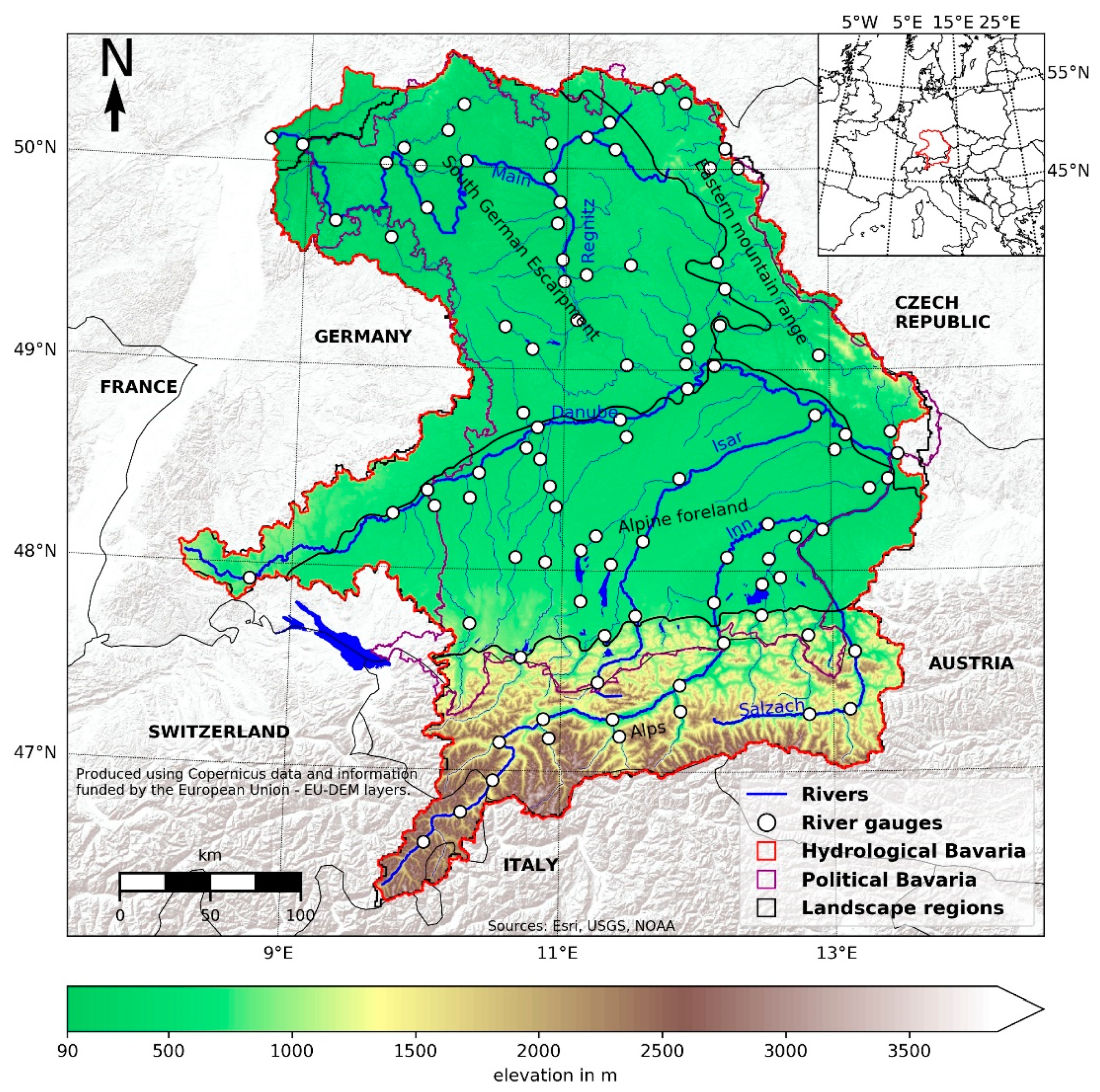
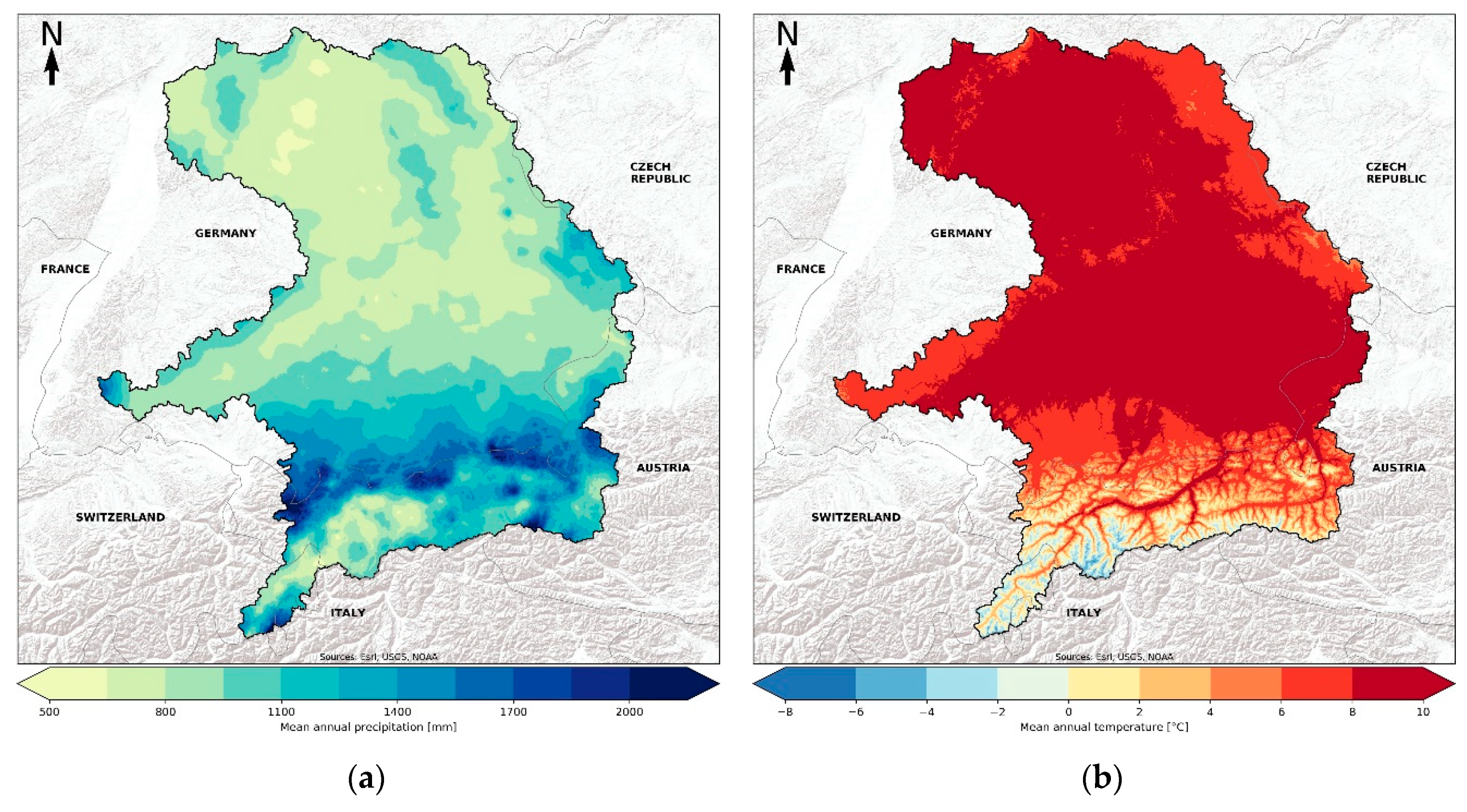
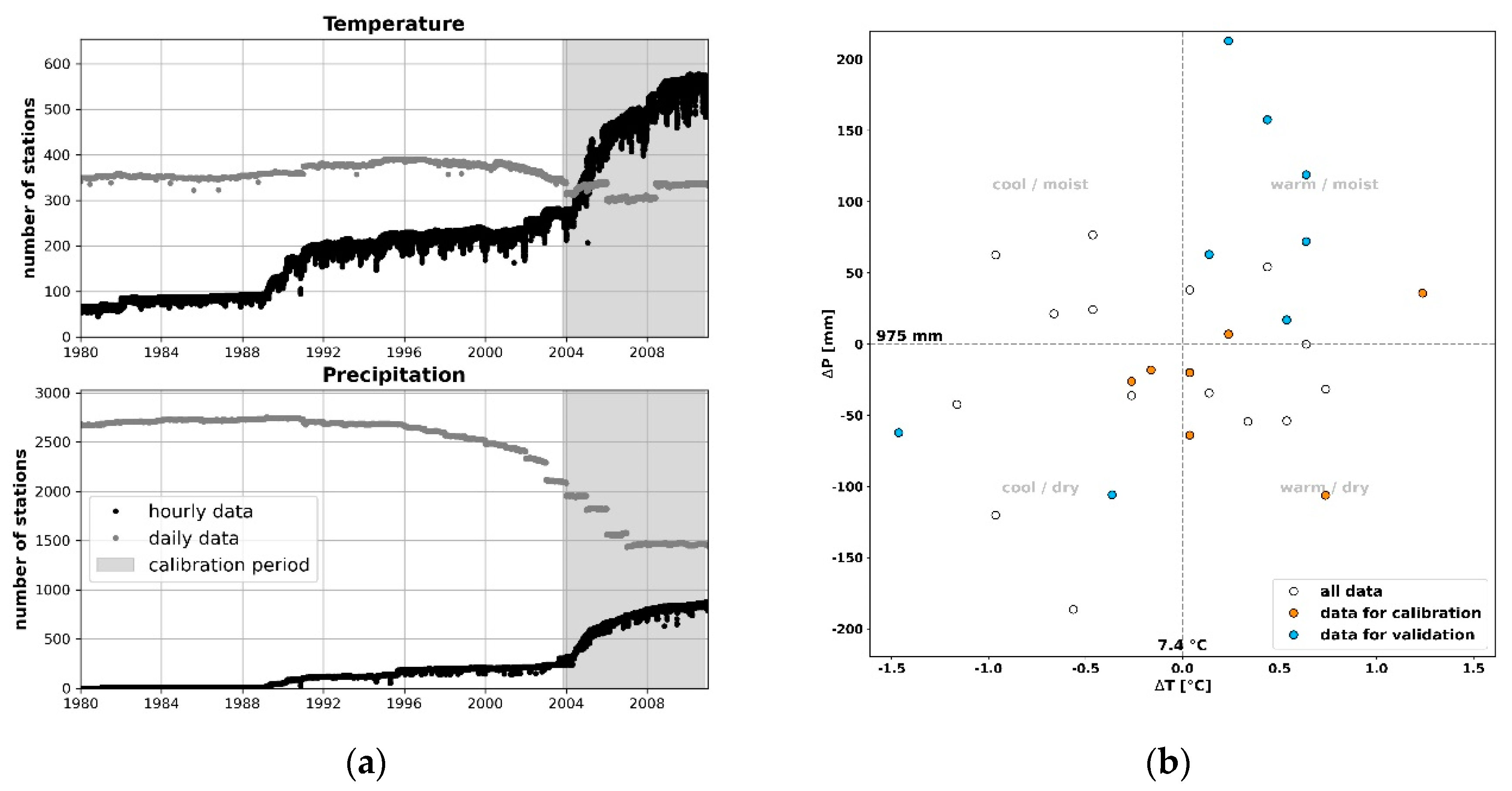

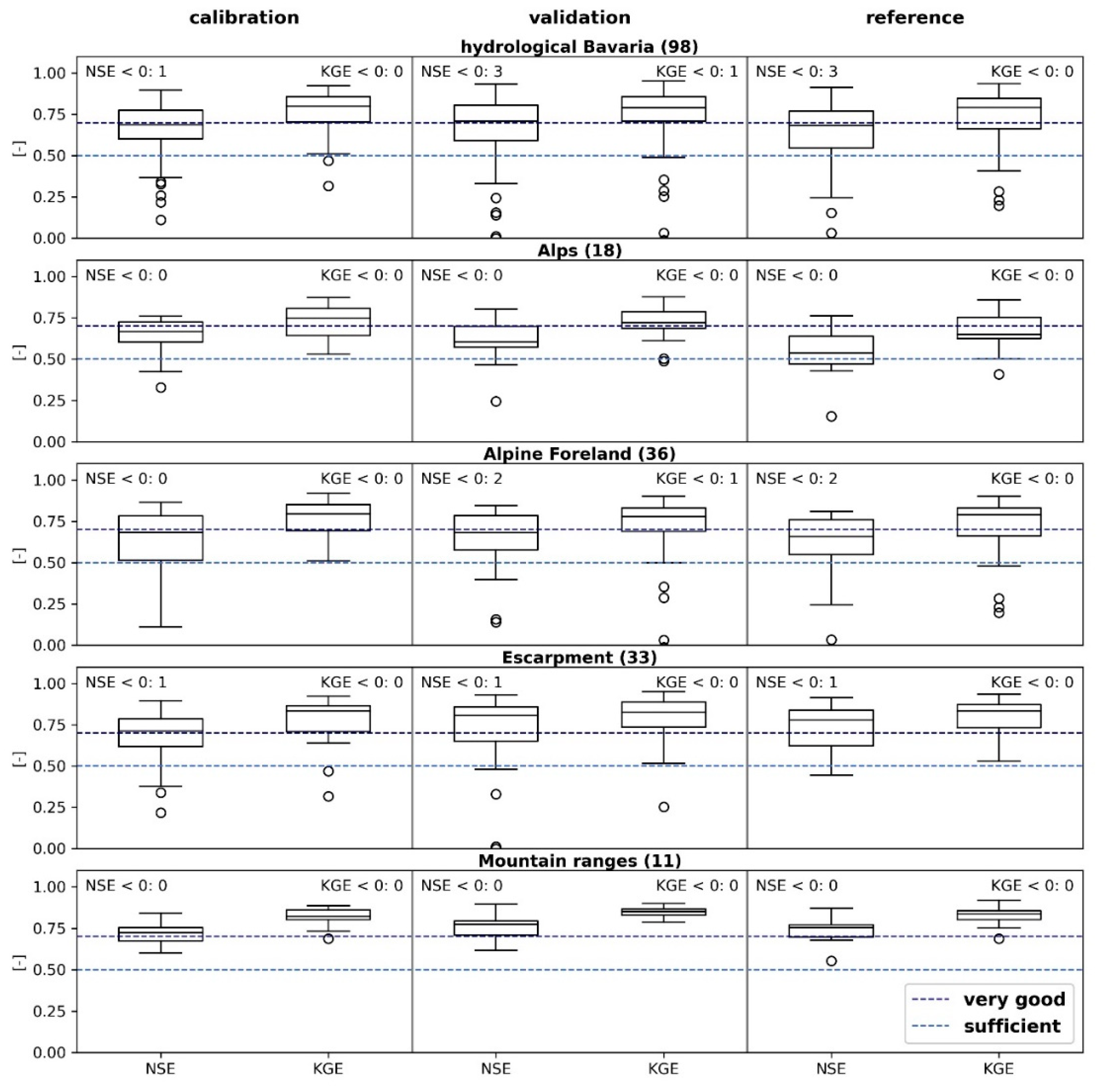
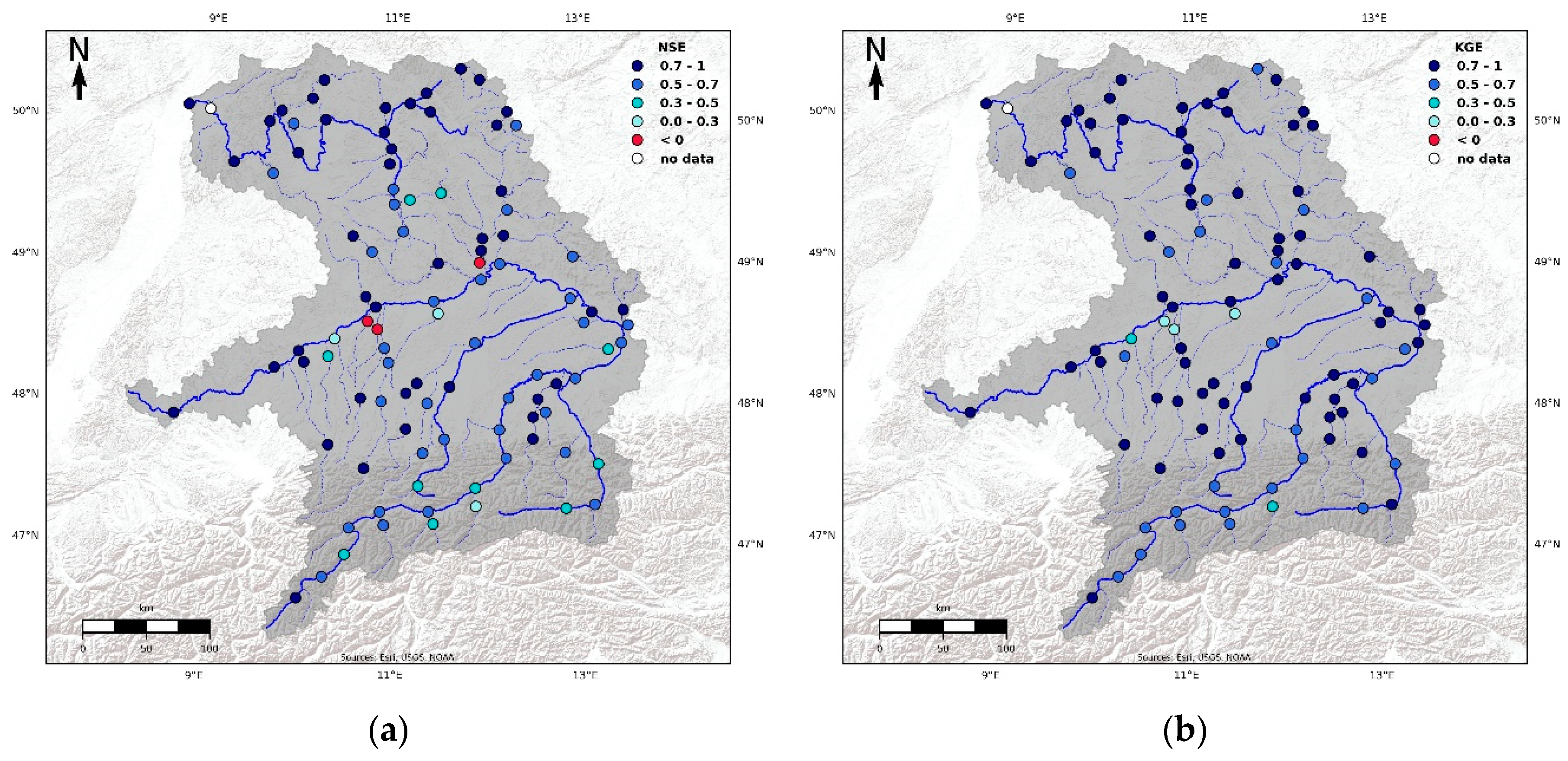
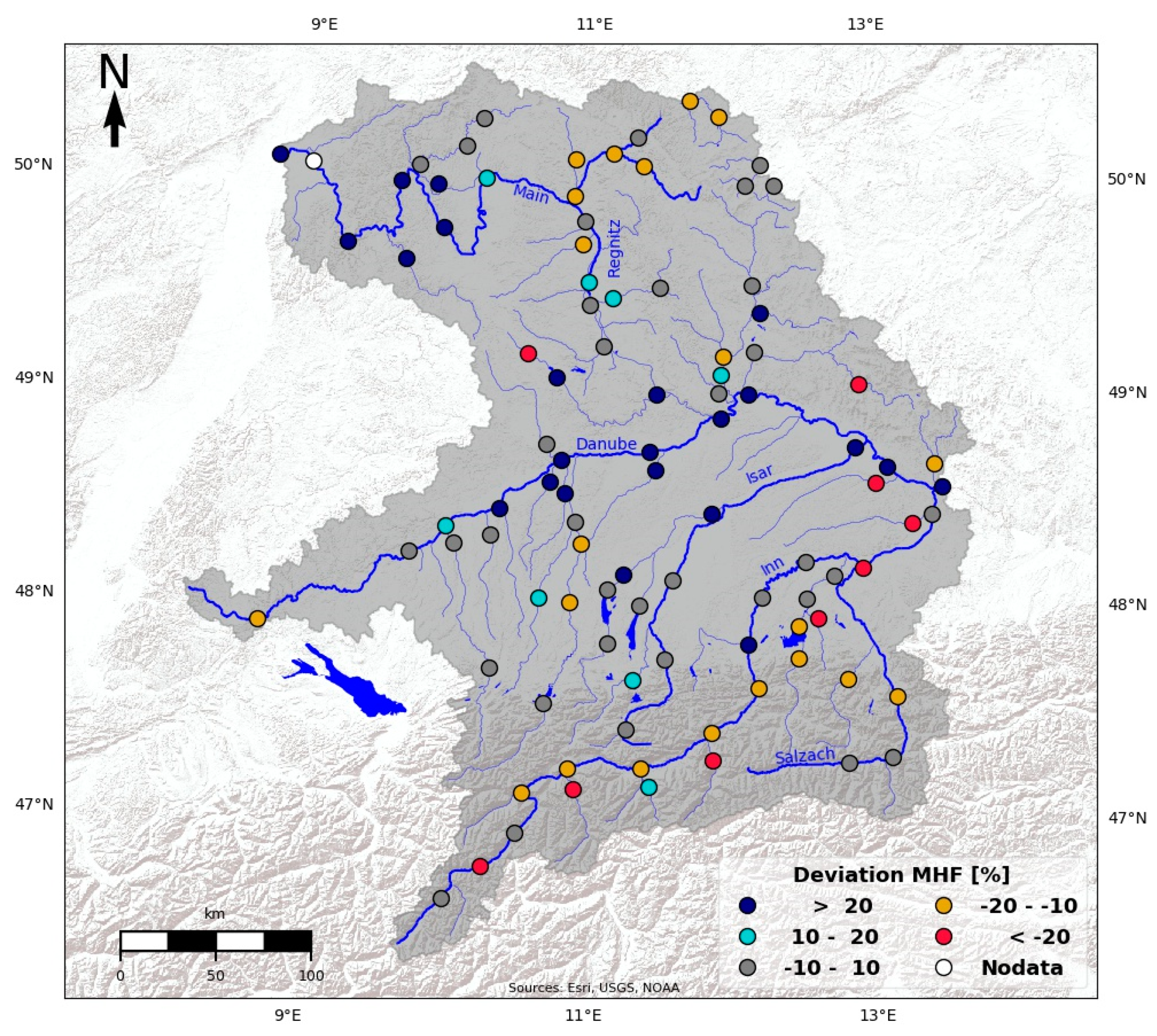
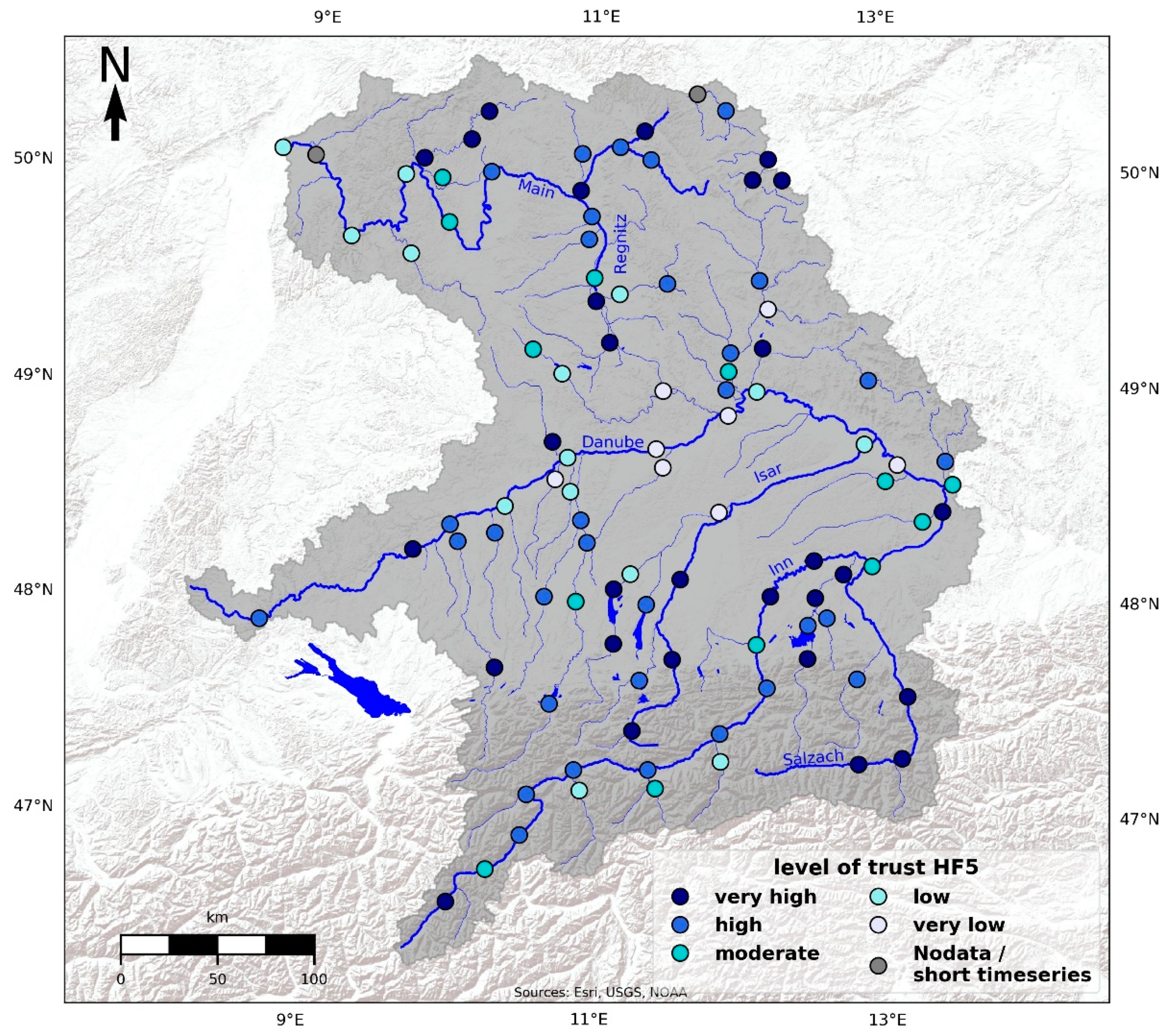


| Type | Name | Resolution | Source |
|---|---|---|---|
| Land use | Corine Land Cover 2006 v17 (CLC) | 100 m × 100 m | [24] |
| Soil | European Soil Database v2.0 (ESDB) | 1:1,000,000 | [25,26] |
| Digital elevation model (DEM) | Digital Elevation Model over Europe (EU-DEM) | 1′ (≅25 m) | [23] |
| Hydrogeology | Hydrogeologische Übersichtskarte 200 (HÜK200) v2.5/International Hydrogeological Map of Europe 1:1,500,000 (IHME1500 v1.1) | 1:200,000/1:1,500,000 | HÜK200 © BGR & SGD 2011, [28]/IHME1500 v1.1 © BGR, Hannover, 2014, [29] |
| Meteorological data | Sub Daily Climate Reference (SDCLIREF) | 500 m × 500 m | |
| Discharge | Gauging stations | Bavarian Environment Agency (LfU) |
| WaSiM Module | Approach | Source (If Available) |
|---|---|---|
| Evapotranspiration | Penman-Monteith | [35] |
| Snowmelt | Enhanced energy balance with snow redistribution by wind and gravitation | [36] |
| Soil water movement | Richards equation | [37] |
| Groundwater movement | Darcy equation | |
| Soil parameterization | Van Genuchten parameter | [27] |
© 2020 by the authors. Licensee MDPI, Basel, Switzerland. This article is an open access article distributed under the terms and conditions of the Creative Commons Attribution (CC BY) license (http://creativecommons.org/licenses/by/4.0/).
Share and Cite
Willkofer, F.; Wood, R.R.; von Trentini, F.; Weismüller, J.; Poschlod, B.; Ludwig, R. A Holistic Modelling Approach for the Estimation of Return Levels of Peak Flows in Bavaria. Water 2020, 12, 2349. https://doi.org/10.3390/w12092349
Willkofer F, Wood RR, von Trentini F, Weismüller J, Poschlod B, Ludwig R. A Holistic Modelling Approach for the Estimation of Return Levels of Peak Flows in Bavaria. Water. 2020; 12(9):2349. https://doi.org/10.3390/w12092349
Chicago/Turabian StyleWillkofer, Florian, Raul R. Wood, Fabian von Trentini, Jens Weismüller, Benjamin Poschlod, and Ralf Ludwig. 2020. "A Holistic Modelling Approach for the Estimation of Return Levels of Peak Flows in Bavaria" Water 12, no. 9: 2349. https://doi.org/10.3390/w12092349
APA StyleWillkofer, F., Wood, R. R., von Trentini, F., Weismüller, J., Poschlod, B., & Ludwig, R. (2020). A Holistic Modelling Approach for the Estimation of Return Levels of Peak Flows in Bavaria. Water, 12(9), 2349. https://doi.org/10.3390/w12092349





